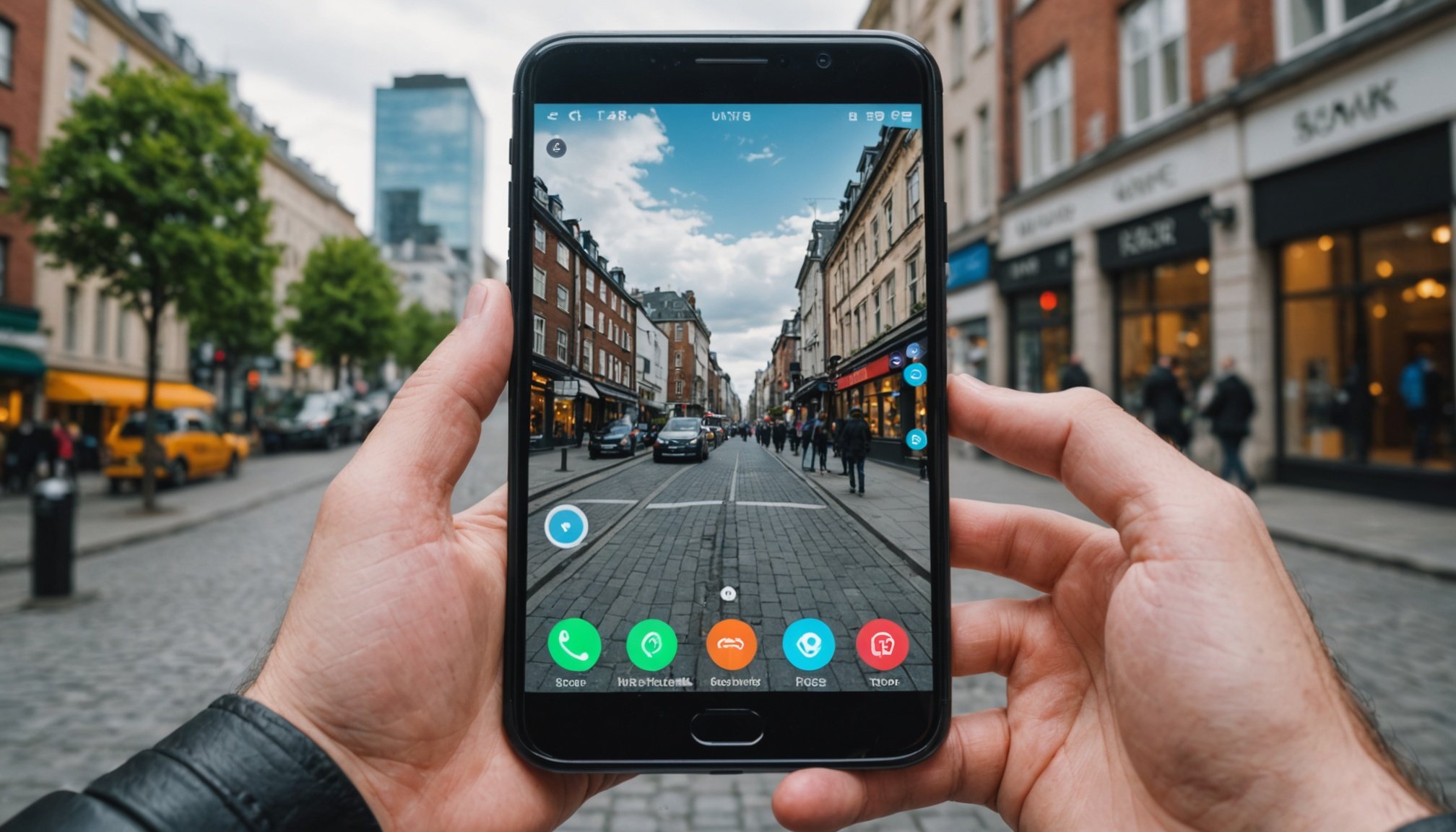Unlocking Augmented Reality: A Guide for Smartphone Enthusiasts
What is Augmented Reality?
Augmented reality (AR) is a technology that seamlessly blends digital information and images with the real world. Unlike virtual reality (VR), which immerses you in a completely digital environment, AR keeps you connected to your real surroundings while adding digital layers to it. This technology relies on both software and hardware to create immersive and interactive experiences.
To understand how AR works, let’s break it down into its key components:
Additional reading : Exploring the relationship between smartphone costs, features, and lifespan: what’s the real value?
Hardware and Sensors
Devices like smartphones, tablets, and AR glasses use cameras, GPS, and motion sensors to understand the environment. For instance, your smartphone’s camera provides a view of the world, while its sensors measure things like movement and orientation, helping the device understand its position and movement in space[5].
Computer Vision
AR relies on computer vision, which lets devices analyze what they’re “seeing” through the camera. It detects surfaces (like a table) and markers (like QR codes) to determine where to place digital elements. Some advanced AR can even recognize specific objects or environments, like landmarks or faces[5].
Have you seen this : Top must-have security apps every smartphone user should download today
Processing
The device’s processor handles the data from its sensors and computer vision algorithms to accurately place virtual objects. This means the device has to calculate things like depth, scale, and positioning in real-time, so the digital overlay feels natural and doesn’t seem out of place[5].
Display
After processing the data, the AR system renders (creates and displays) the digital objects on the screen, matching them to the real-world environment. So, if you’re looking at your phone screen, you’ll see the real world through the camera view with digital elements layered on top[5].
Interaction
Many AR systems allow interaction with virtual objects, such as rotating, resizing, or “moving” them by tapping or using hand gestures. These interactions are tracked by sensors and the camera, which then update the view in real-time[5].
Types of Augmented Reality Devices
When it comes to experiencing AR, you have several device options, each offering unique benefits and use cases.
Smartphones and Tablets: The Simplest Option
Smartphones and tablets are by far the easiest and most accessible way to experience AR. Virtually all top smartphones today support AR applications, with over 90% of smartphones being AR-enabled. This means they have the necessary computing processors and input devices (like cameras) built-in to support AR apps[1].
To get started, all you need to do is download an AR app and give it access to your camera. The app will then process information about the world around you and show you images overlaid on top of your camera feed. For example, apps like IKEA Place allow you to see how furniture would look in your home before making a purchase[4].
AR Glasses and Headsets: The Best Augmented Reality Devices
While smartphones and tablets offer seamless AR experiences, AR smart glasses and headsets are the gold standard for immersive AR. These devices can provide real-time captions, translations, or specific text-based instructions. In the consumer world, AR glasses like XReal Specs allow users to project a virtual screen in front of their vision, connected to a smartphone, tablet, or laptop[1].
Here’s a comparison of the key features of these devices:
| Device | Accessibility | Immersiveness | Use Cases |
|---|---|---|---|
| Smartphones and Tablets | Highly accessible, widespread availability | Moderate immersiveness | General AR apps, furniture placement, beauty try-ons |
| AR Glasses and Headsets | Less accessible, more expensive | High immersiveness | Enterprise applications, real-time translations, virtual screens |
Augmented Reality in Social Media
AR has become a central element in social media marketing, offering brands innovative ways to engage their target audience.
Trends and Opportunities
Platforms like Facebook, Instagram, Snapchat, and TikTok have integrated AR filters and effects, allowing brands to create interactive and immersive experiences. For instance, Snapchat’s AR technology enables over 200 million users to use AR every day, with expectations that by 2025, almost 75% of the global population will be regular AR users[2].
Personalization and AI
The combination of AI and AR makes it possible to create personalized and realistic filters tailored to individual user preferences. AI-powered tools analyze user behavior and preferences to provide tailored AR experiences, increasing engagement and brand awareness[2].
Practical Insights for Brands
- Distribute Content Across Platforms: Brands should not rely exclusively on one platform but distribute their AR content across various social networks to reach a wider audience and minimize risks.
- Focus on User Value: The focus should always be on the added value for the user. Interactive and entertaining content promotes engagement and loyalty to the brand.
- Invest in Technology and Training: Investing in appropriate technologies and training is advisable to increase the personalization and effectiveness of marketing campaigns[2].
Augmented Reality in Navigation
One of the most practical and innovative uses of AR is in navigation, particularly with Google Maps.
Google Maps AR Live View
Google Maps AR Live View leverages AR to provide intuitive walking directions by overlaying arrows, landmarks, and information directly onto your surroundings. This feature uses your smartphone’s camera and ARCore/ARKit technology to make navigation clearer and more engaging[3].
Here are some key benefits and features of Google Maps AR Live View:
- Real-Time Directions: Directional arrows, distance markers, and nearby landmarks appear in your camera view, helping you stay oriented without constantly checking a 2D map.
- Landmark Identification: The feature identifies iconic landmarks like parks, buildings, and attractions and displays their distance and directions in real time.
- Category Search: In select cities, you can search for categories (e.g., restaurants, malls) directly within the AR interface.
- User Interaction: You can easily toggle between Live View and 2D map navigation by tilting your phone horizontally or vertically[3].
Augmented Reality in Marketing
AR is transforming the marketing landscape by offering businesses unprecedented opportunities to engage audiences and enhance user experiences.
Revolutionizing Product Visualization
AR enables customers to visualize products in real-time. For example, furniture companies use AR apps to allow users to see how a couch fits into their living room, eliminating guesswork and enhancing the purchasing experience[4].
Immersive Brand Storytelling
VR provides a platform for creating compelling narratives that immerse users in a brand’s story. However, AR also plays a crucial role in storytelling by allowing users to interact with digital elements in their real-world environment. This can include virtual try-ons, interactive advertisements, and gamified experiences[4].
Interactive Advertising Campaigns
AR-powered advertisements let users interact with products directly through their devices. For instance, beauty brands offer AR filters to let users try on makeup virtually, increasing engagement and conversion rates. Here are some tips for creating effective AR advertising campaigns:
- Use Interactive Filters: Allow users to try on products or see how they would look in different settings.
- Gamify Experiences: Create AR-based games or scavenger hunts to drive user interaction.
- Integrate Across Channels: Use AR campaigns on websites, apps, and social media platforms to reach a broader audience[4].
Benefits and Challenges of Augmented Reality
Benefits of Augmented Reality
- Enhanced User Experience: AR provides immersive and interactive experiences that enhance real-world environments.
- Increased Engagement: AR filters and effects on social media increase user engagement and brand awareness.
- Informed Decisions: AR helps customers make informed decisions by visualizing products in real-time.
- Marketing Innovation: AR offers innovative marketing strategies that set brands apart in competitive markets[2][4].
Challenges of Augmented Reality
- Privacy Concerns: The use of cameras and sensors raises privacy concerns, making it important for brands to have a clear privacy policy.
- Cost and Complexity: Creating complex AR filters and effects can be costly and require significant technical expertise.
- Technical Limitations: AR technology still has limitations, such as the need for robust Street View coverage for features like Google Maps AR Live View[3].
Practical Advice for Smartphone Users
If you’re eager to dive into the world of AR, here are some practical tips to get you started:
Choosing the Right Apps
- IKEA Place: For furniture placement and home decor.
- Snapchat: For social media AR filters and effects.
- Google Maps: For AR navigation with Live View.
- Beauty Apps: For virtual makeup try-ons.
Ensuring Optimal Performance
- Check Device Compatibility: Ensure your device supports ARKit (for iOS) or ARCore (for Android).
- Update Software: Keep your device and apps updated to ensure the latest AR features and performance.
- Use High-Quality Cameras: The quality of your device’s camera can significantly impact the AR experience.
Interacting with Digital Elements
- Use Hand Gestures: Many AR apps allow you to interact with virtual objects using hand gestures or taps.
- Adjust Settings: Adjust the settings within the app to optimize the AR experience for your environment.
Augmented reality is no longer a futuristic concept but a reality that is transforming various aspects of our lives, from social media and marketing to navigation and product visualization. By understanding how AR works, the types of devices available, and the practical applications, you can unlock a world of immersive and interactive experiences right from your smartphone.
As Clarence Dadson, CEO of Design4Real, notes, “The future of AR in social media marketing remains exciting. Despite the challenges, there are numerous opportunities for innovative and effective marketing strategies. Brands that are willing to adapt and invest in new technologies will reap the benefits of these developments.”[2]
Whether you’re a marketer looking to engage your target audience or a consumer eager to explore new ways to interact with the world, AR offers a wealth of possibilities. So, go ahead and dive into the world of augmented reality – you might just find that it changes the way you see and interact with the real world.











